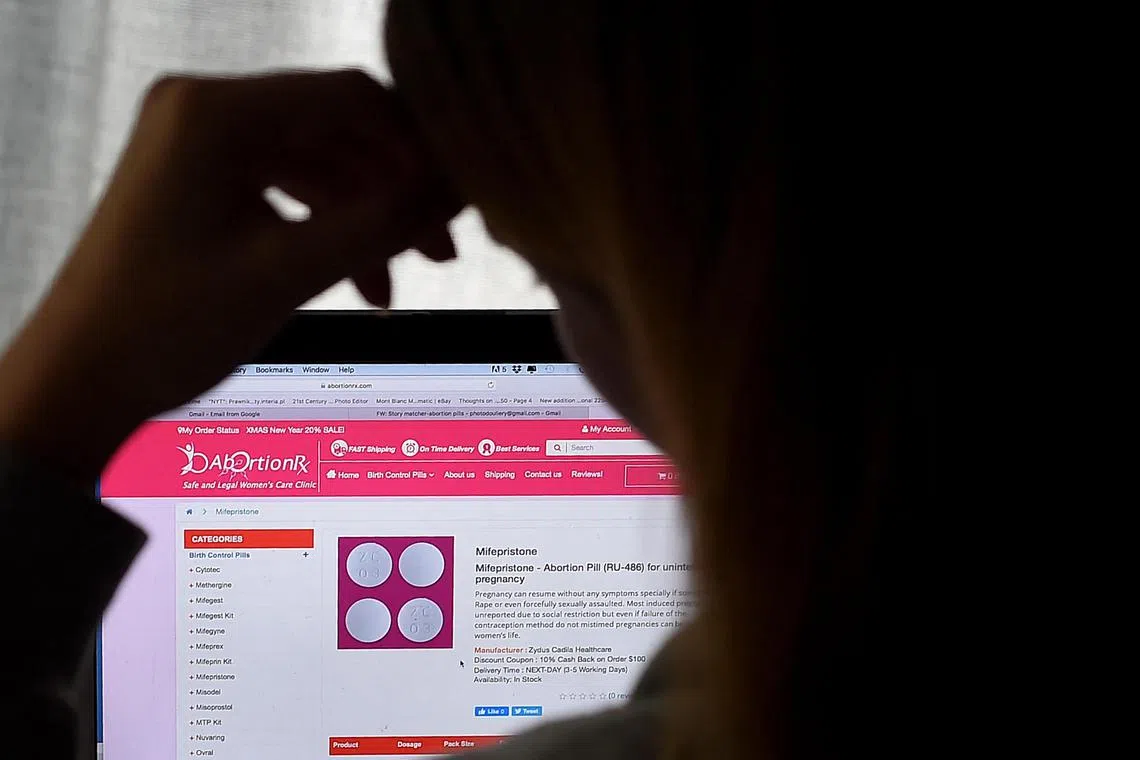Conflicting US rulings leave fate of abortion pill in doubt
Sign up now: Get ST's newsletters delivered to your inbox

Banning the widely used drug mifepristone, or RU-486, nationwide in the United States boosts conservatives’ efforts to further restrict abortion rights.
PHOTO: AFP
Follow topic:
WASHINGTON – Conflicting rulings by two federal judges have left the future of abortion pills in the United States deeply uncertain, most likely placing the divisive issue squarely in the lap of the Supreme Court.
A ruling on Friday by federal judge Matthew Kacsmaryk in Texas banned the widely used drug mifepristone (RU-486) nationwide, boosting conservatives’ efforts to further restrict abortion rights after the Supreme Court in 2022 allowed states to prohibit them.
The unprecedented rejection of a drug approved in 2000 by the US Food and Drug Administration (FDA) – and found safe by scientific consensus – sparked outrage on the political left.
Judge Kacsmaryk, in his ruling, adopted language used by abortion opponents, referring to abortion providers as “abortionists” and saying the drug was used to “kill the unborn human”.
His ruling brought an immediate vow from the Biden administration and the drug’s maker to appeal the matter in federal court.
Attorney-General Merrick Garland said the Justice Department would ask the appeals court to stay the ban by Judge Kacsmaryk, an ultra-conservative Donald Trump appointee, until the case is finally resolved.
If the Texas ruling holds, it would complicate matters not just in the states now banning or sharply limiting abortions, but also in those where the procedure remains legal.
Widely used
Mifepristone has been used as part of a two-drug regimen by 5.6 million women since 2000.
But adding to the uncertainty and increasing the odds that the matter ends up before the Supreme Court was a contradictory ruling from a Washington state judge that came just hours after Judge Kacsmaryk’s.
District Judge Thomas Rice, a Barack Obama appointee, ruled in a separate case – brought by several states where abortion is legal – that mifepristone is “safe and legal” and that the FDA must preserve access to it in more than a dozen states.
For now the drug remains legal, Ms Alexis McGill Johnson, the head of Planned Parenthood, a leading abortion provider and advocacy group, insisted on Friday.
Several abortion clinics also said on Friday that they would continue using mifepristone until ordered not to by the FDA, US media reported.

US federal judge Matthew Kacsmaryk banned the widely used drug mifepristone, also known as RU-486, nationwide.
PHOTO: REUTERS
Judge Kacsmaryk paused the effect of his ruling for a week, allowing time for the administration and drugmaker Danco Laboratories to file before the US Fifth Circuit Court of Appeals in Louisiana, which hears cases from Texas.
The Justice Department is still reviewing District Judge Rice’s ruling, Mr Garland said in a statement.
‘Remains safe’
Given the sharply conflicting court rulings, the Justice Department might opt to take the case directly to the Supreme Court and not wait for the Fifth Circuit to act.
The Supreme Court could decide to take up the case on an emergency basis, which would require making room in an already crowded agenda at the end of the current term.
In that case, the court – with six conservative justices outnumbering the three liberals – could hear the case within days, or weeks, but some time before the current session ends on June 30.
Chief Justice John Roberts, a conservative, is deeply protective of the image of the institution, and might vote with the three liberals in favour of the long-settled approval of mifepristone. The additional vote of one other conservative could provide a majority for the drug.
Health law specialist Lawrence Gostin of Georgetown University said he expects the case to be fast-tracked by the Supreme Court and noted that historically, the court sided with federal health regulators.
However, he added: “The outcome is far from certain. The Supreme Court now has a conservative supermajority that has already overturned the constitutional right to abortion... This is a perilous moment for American women.”

The unprecedented rejection of a drug approved in 2000 by the US Food and Drug Administration and regarded as safe sparked outrage on the political left.
PHOTO: AFP
The court’s ruling last June to overturn the longstanding Roe v Wade decision protecting abortion rights
Most of them involve mifepristone in a two-drug regimen. A patient takes a mifepristone pill to end the pregnancy, then a day later takes the drug misoprostol to induce contractions that expel the embryo or foetus.
Misoprostol can be used on its own to cause abortions, but the two-step procedure is considered more effective, while misoprostol, when used alone, causes more cramping and bleeding.
More than half of abortions in the US are done with medication.
Judge Kacsmaryk, in his ruling, said the two-drug regimen had resulted in “thousands of adverse events suffered by women and girls”, including intense bleeding and psychological trauma.
But the FDA, researchers and the drugmaker say decades of experience have proven the medication to be safe and effective.
Michigan Governor Gretchen Whitmer, a Democrat, tweeted: “Despite this ruling, I want to be clear: abortion, including medication abortion, remains safe and legal in the state of Michigan.”
Women’s March, which has been organising major women’s rights demonstrations in recent years, called for a nationwide rally April 15 in defence of abortion rights. AFP

